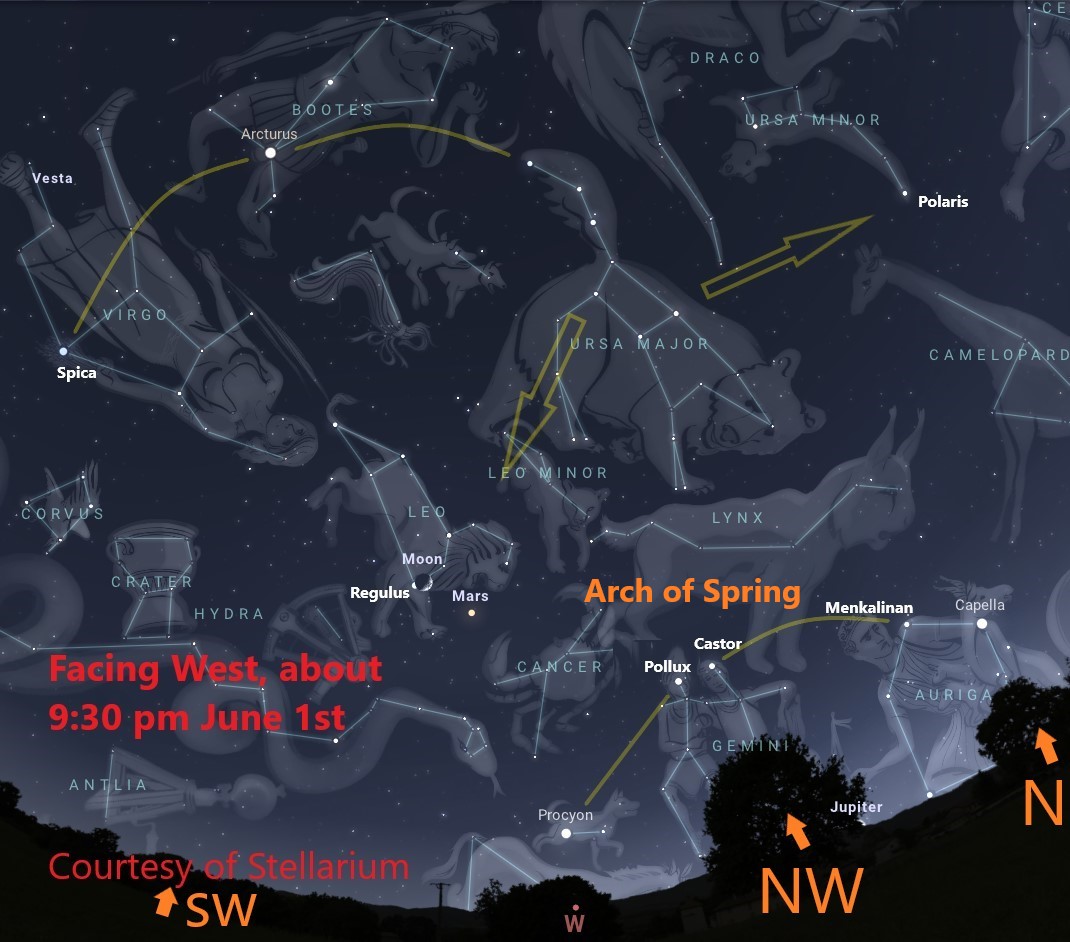LION AROUND THE SKY
This is the 79th edition of my Sky Ranger blog, and it so happens that the heart of one of June’s most prominent constellations is 79 light years away. I am referring to the star Regulus, brightest light in the constellation Leo, the Lion. One of the best ways to find Regulus and Leo is to start with the Big Dipper, high in the northwestern sky during the evening at this time of year. The Dipper can help us locate several prominent sights in the sky. As is well known, the two stars in the bowl farthest from the handle always point to Polaris, the North Star- so called because it is located directly above the North Pole of the Earth. You can follow the arc of the Big Dipper’s handle to locate bright Arcturus and speed on or spike to Spica, in the south. That’s how I was taught to remember how to find them, over fifty years ago now. If you were to draw a line from the two stars in the Big Dipper’s bowl closest to the handle, the opposite way from the line to Polaris, it points to Regulus.

The stars of Leo, the Lion shine in June’s western skies. Turn the map slightly so that the arrow for the direction you are facing appears upward.
Regulus is a large, luminous star, about 100 times brighter than the Sun. Although it looks like one rather bright star in the night sky, telescopes show that it is actually the combined light of four stars. If your sky is not heavily light polluted or you use binoculars, it is possible to make out a fairly decent lion in the sky, with the front part forming a backwards question mark with Regulus at the point. A triangle of stars make up the hind part and his tail, and faint stars nearby the paws. The Lion is crouching in the grass, waiting to pounce on you. As stars go, Regulus is relatively close to us at 79 light years away. Space is so vast that this distance can also be expressed as 474,000,000,000,000 miles (yes, twelve zeroes!).
In Greek mythology the stars of Leo represent the Nemean Lion. The Lion would seize women as hostages, luring warriors to try to kill it, only to find that the thick hide resisted their clubs, swords, and spears. The hero Hercules finally defeated the lion by strangling it with his bare hands, with Zeus placing both in the sky to commemorate the event.
This June, the celestial lion has some company in the sky. The planet Mars will be an almost equal match in brightness to Regulus, but notably orange in color as opposed to the star’s bluish white. Mars will appear to the lower right of Regulus as the beginning of June, as shown on the map, most closely side by side with it around the 16th & 17th, and to the upper left thereafter. The moon will pass through the area on the 1st and then again, one orbit around the Earth later, on the 29th.
If you turn our map slightly so that northwest is at the bottom, you can see that it is still possible to see the Arch of Spring during the early evening at the beginning of June, getting low in the west. The Gemini twins, Pollux and Castor, form the keystone, with Procyon the south leg and the stars Menkalinan and Capella the north leg. I discussed the Arch of Spring in greater detail in last month’s issue of this blog.
Although I don’t think I have ever seen any lions on site (except in the sky) Gateway Arch National Park hosts a surprising amount of wildlife, particularly birds. In cooperation with the Lights Out Heartland (LOH) organization, an acoustic logger was installed at the Park last September, listening to flight calls during the fall migration. You can learn about the results of this study by attending our next Gateway to the Stars program, “Echoes of the Night: Exploring Nocturnal Bird Flights at Gateway Arch National Park.” LOH founder Don Ficken will speak about the results of this study on Saturday, June 7 at 7 pm, in the Park’s Education Classroom. Telescope viewing of the Moon and Mars will follow this presentation, weather permitting.
Finally, I want to express my appreciation to Sue Ford, who will be retiring from a long tenure as part of our Park’s Exhibit Staff at the end of May. It is she who has posted nearly all the seventy-nine editions of this blog to the Park’s website and social media since the first post in 2018 , formatting text and images so that it is usable. Sue’s contribution is greatly appreciated.
